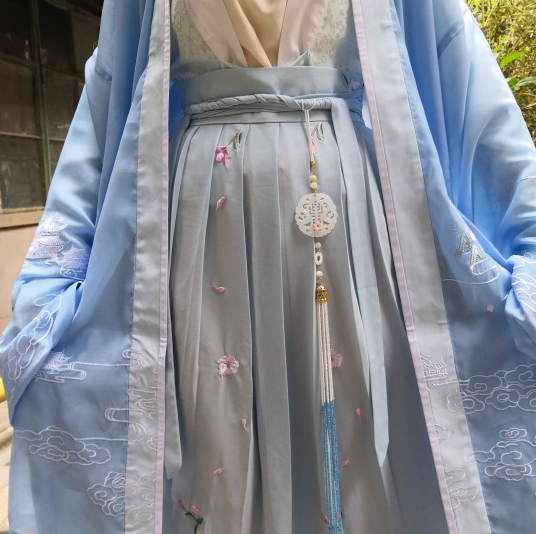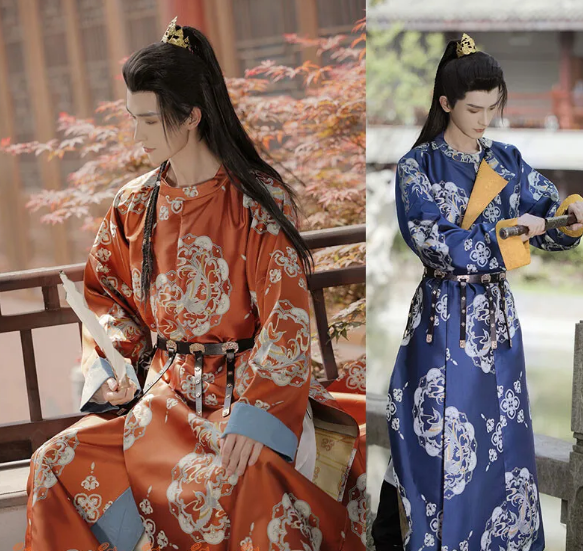Yes, there are various styles of Hanfu belts, such as “Tao belt” (silk belt or narrow belt), “Ke belt” (narrow belt, sometimes used with jade belt hooks), and “kua belt” (belt decorated with plaques or decorations).
Overview of Hanfu Belts
Hanfu belts stand out as a critical component of traditional Chinese clothing, merging practicality with ornamental elegance. These belts, originating from ancient China, serve not only as functional accessories but also as symbols of Chinese fashion and cultural identity.
Definition and Historical Significance
Hanfu belts first appeared in the early dynasties of China, initially serving as simple sashes to secure robes. As time progressed, especially during the prosperous Tang dynasty, artisans started crafting these belts into more ornate pieces. They often used luxurious materials like silk and brocade and adorned them with intricate embroidery and precious stones. These belts not only held robes in place but also indicated the wearer’s social status and wealth. In the imperial courts, different belt designs signified various ranks and positions, making them key elements in the social hierarchy of ancient China.

Role in Traditional Chinese Attire
In traditional Chinese fashion, a Hanfu belt does more than fasten a garment; it acts as a focal point that completes and enhances the attire. It cinches at the waist, creating a balanced and graceful silhouette that complements the flowing robes. During special events and ceremonies, choosing the right Hanfu belt holds significant importance. For instance, red belts often feature in weddings, symbolizing joy and prosperity, while more subdued designs mark somber occasions. Today, Hanfu belts have gained popularity again, blending traditional designs with modern fashion. This resurgence has brought these historic accessories to a worldwide audience, maintaining their cultural relevance and appeal.
Each Hanfu belt, with its unique design and artistry, narrates a piece of Chinese history, reflecting the rich legacy of traditional Chinese fashion.
Taodai Belts
Taodai belts, a distinguished accessory in traditional Chinese attire, showcase a unique blend of elegance, functionality, and cultural significance. These belts, originating from ancient China, have evolved over centuries, embodying the richness of Chinese fashion heritage.
Description and Historical Background
The Taodai belt traces its roots back to ancient China, likely originating during the Tang dynasty, known for its cultural and sartorial advancements. Initially designed as a practical solution for securing Hanfu robes, Taodai belts have undergone significant evolution. During the Ming and Qing dynasties, they transformed from simple fabric sashes into more elaborate and decorative items. Although the exact originator of the Taodai belt is not known, its development is a testament to the era’s innovative approach to fashion. In these times, the Taodai belt was more than just a functional accessory; it became a symbol of social status and fashion consciousness.
Design Variations and Materials
Taodai belts exhibit a diverse range of styles and materials, each reflecting a different aspect of Chinese culture. On the simpler end, some Taodai belts are made of plain silk, suitable for everyday wear. In contrast, others meant for special occasions feature elaborate designs with embroidery, tassels, and even intricate jade inlays. The materials used in Taodai belts include fine silks, rich brocades, and sometimes even precious metals for added opulence. This variety not only demonstrates the skill and artistry in traditional Chinese belt-making but also allows individuals to express their personal style and adhere to cultural norms.
Features and Cultural Significance
Taodai belts are known for their distinct features: the width of the belt, the intricate way it ties around the waist, and the possibility of it being adorned with various embellishments. These belts are more than just fashion accessories; they carry deep cultural meanings. In traditional ceremonies, the color and design of a Taodai belt can convey specific messages or wishes, like red for good fortune or gold for prosperity. In modern times, these belts have found their way into contemporary fashion, blending ancient motifs with modern trends. This fusion helps to keep the tradition alive, appealing to a new generation and maintaining the cultural relevance of Taodai belts.
The enduring appeal of Taodai belts in fashion and culture underscores their importance in the tapestry of Chinese heritage. Each belt is not just a fashion statement but a narrative of history, art, and tradition.
Ke Belts
Ke belts, slender and minimalistic, are a fundamental aspect of traditional Chinese dress, particularly Hanfu. These belts, known for their understated elegance, have a long history in Chinese fashion.
Characteristics and Function
Ke belts typically feature a narrow design, crafted from materials like silk or cotton. Their primary purpose is to secure Hanfu garments, ensuring a neat and fitting appearance. Unlike broader, more ornate belts, Ke belts emphasize subtlety, complementing the Hanfu without overshadowing its design. The origin of Ke belts aligns with the evolution of Hanfu. As Hanfu styles diversified, the need for a practical yet unobtrusive belt gave rise to the Ke, reflecting the practical needs and aesthetic sensibilities of ancient China.
Usage with Jade Belt Hooks
Pairing Ke belts with jade belt hooks is a practice steeped in history and elegance. Jade belt hooks, dating from the Spring and Autumn period, were symbols of nobility and status. When used with a Ke belt, a jade hook not only secures the belt but also adds historical and aesthetic value. Jade, revered in Chinese culture for its purity and moral significance, complements the simplicity of the Ke belt. This combination reflects a balance, embodying the traditional Chinese yin and yang philosophy.
In modern fashion, this timeless pairing inspires contemporary designers. They often incorporate jade hooks with modern Ke belts, blending ancient symbolism with current trends. This approach keeps the cultural essence of these items alive while making them relevant for today’s fashion enthusiasts.
Kua Belts
Kua belts, known for their ornate designs, play a pivotal role in traditional Hanfu attire. These belts stand out for their distinctive features and rich ornamentation, making them not just functional accessories but also symbols of cultural heritage.
Distinctive Features and Ornamentation
Kua belts typically feature a broad design, often lined with plaques or intricate ornaments. Artisans craft these belts using various materials, including silk, brocade, and sometimes leather, depending on the level of formality and occasion. The most striking aspect of Kua belts is their ornamentation. They often incorporate elements like embroidered patterns, colorful stones, and metalwork, showcasing the intricate craftsmanship of traditional Chinese artisans. This ornamentation not only enhances the belt’s aesthetic appeal but also serves as a display of the wearer’s status and taste.

Role in Traditional Hanfu Attire
In traditional Hanfu attire, Kua belts serve a crucial role in completing the ensemble. They cinch at the waist, accentuating the garment’s silhouette and adding an element of sophistication. More than just functional items, Kua belts often convey certain social or cultural messages. For example, the specific designs and materials used can signify the wearer’s social status, region, or even specific values and beliefs. In traditional ceremonies and events, selecting the appropriate Kua belt is an important aspect of adhering to cultural norms and expressing respect for the occasion.
In modern times, the elegance and historical significance of Kua belts continue to inspire fashion designers. They often incorporate traditional motifs into contemporary designs, creating a beautiful blend of past and present. This enduring appeal ensures that Kua belts remain not only relevant but also cherished elements of Chinese cultural and fashion heritage.